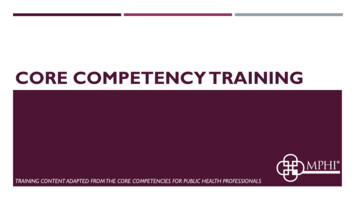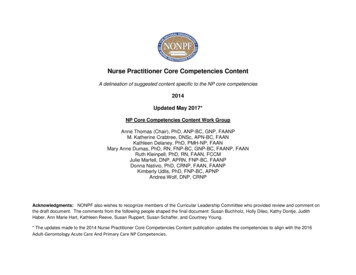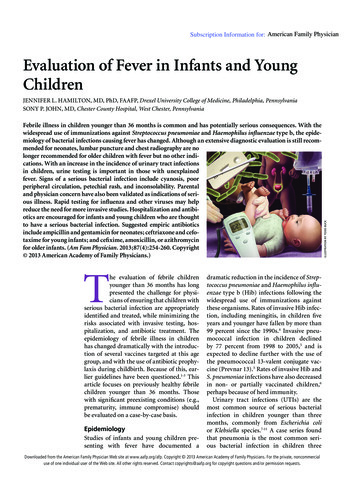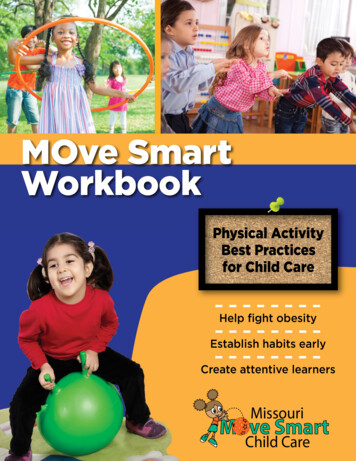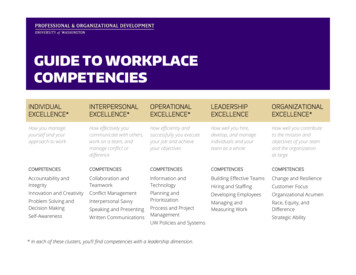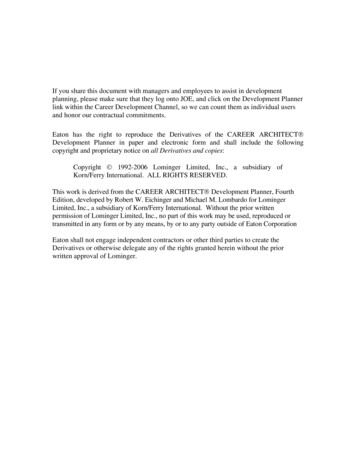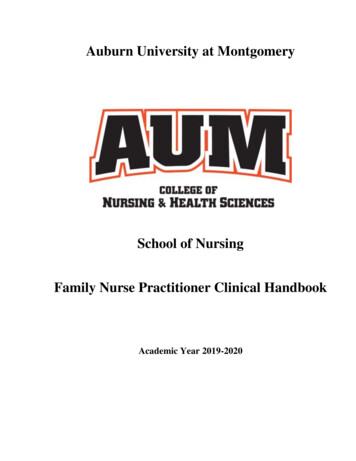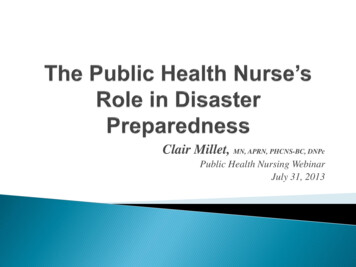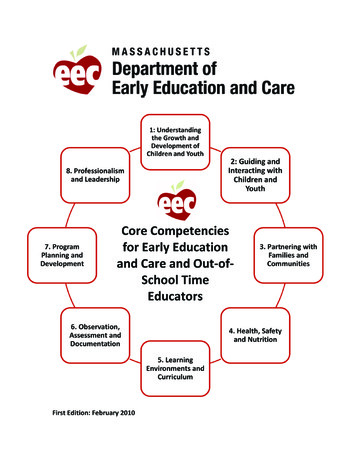
Transcription
Massachusetts Department of Early Education and CareCore Competencies for Early Education and Care and Out of School Time Educators2.4.2010Core Competencies for Early Education and Care and Out-of-SchoolTime EducatorsTable of ContentsIntroductionPage 3A Quick Reference to the Core Competency Areas and SubcategoriesPage 10Core Competency Areas, Subcategories, and IndicatorsPage 11Appendix A: Glossary of TermsPage 43Appendix B: Alignment with Course Categories in 606 CMR 7.09(18(b)Page 50Appendix C: Alignment with Quality Rating and Improvement SystemPage 51Appendix D: ContributorsPage 522
Massachusetts Department of Early Education and CareCore Competencies for Early Education and Care and Out of School Time Educators2.4.2010IntroductionWhy core competencies are important:An important first step for any workforce development system is defining core competencies, or theknowledge and skills that are necessary to be effective in working with children and youth.The National Child Care Information Center (NCCIC) defines core competencies as, “The range ofknowledge and observable skills that adults working with young children need to facilitate child learningand development, linked to early learning guidelines1.”The development of a core set of indicators is a critical step in building the foundation of a strongworkforce. Bellm (2005) states,“Competencies can help the field as a whole to clarify its goals across all age groups (frominfants through elementary school students), job categories (including program administration)and career stages (entry-level, mid-career and advanced). Competencies can help individualsidentify what they are trying to accomplish, articulating the body of knowledge and skill that canbe developed through training and education. And for parents and the general public, a systemof teacher competencies can help build wider awareness of and respect for early care andeducation as skilled professional work.”Core competencies provide educators with a framework for professional development -- a road map -leading them to new credentials, or guiding ongoing professional development at various career stages.Educators must be able to “recognize themselves” as professionals based on the knowledge andcompetencies they have gained through education and practical applications rather than being definedsolely by the setting in which they work or by their degree attainment. A competency-based systemmust be designed to be flexible, with a variety of pathways for educators to achieve the requiredcompetencies.Core competencies not only include what is essential to work directly with children and youth but alsothe leadership skills that are required to ensure program quality and accountability as well asadvancement of our field. The Massachusetts Core Competencies are being integrated into professionaldevelopment educational opportunities across the field and will eventually become the basis forapproved training, coursework development, ongoing evaluation of staff, and for awarding credentials.In addition, the Core Competencies align with the five categories of indicators EEC has identified for theQuality Rating and Improvement System (QRIS) that EEC began developing in the spring of 2008 to“assess, improve, and communicate the level of quality in early education and care and tem.html3
Massachusetts Department of Early Education and CareCore Competencies for Early Education and Care and Out of School Time Educators2.4.2010settings”2 . As educators gain skills and knowledge that increase their level of competency, the programsthey work in are better positioned to attain higher levels of quality on the QRIS scale (see Appendix C).How the Massachusetts Core Competencies were developed:Massachusetts is among several states developing and implementing core competencies for earlyeducation and care. Massachusetts is, however, unique in creating a single set of core competencies forall types of care and for educators working with children and youth from birth to 14 years old, 16 withspecial needs. The following goals were established to guide the development of the 8 core competencyareas and accompanying indicators: To create a set of shared expectations that is reflective of the knowledge, skills, and dispositionsnecessary for all educators, youth workers, and administrators working in the early education andcare and out-of-school time field. To capture the breadth and depth of what educators, youth workers, and administrators in the fieldshould know and be able to demonstrate. To guide the development of an infrastructure of coursework and other professional developmentopportunities. To provide early education and care and out-of-school time educators, youth workers, andadministrators with a framework for professional development. To recognize professionalism and leadership in the early education and care and out-of-school timefield. To create a system for recognizing achievements in educational attainment and awardingcredentials in the early education and care and out-of-school time field. To serve as a foundation to educate parents and guardians on the elements (knowledge, skills, anddispositions) of a quality educator, youth worker, and administrator.Development of the Massachusetts Core Competencies began almost as soon as EEC was established inJuly 2005 with research into current knowledge and related standards. Accreditation standards fromNAEYC, NAFCC, MSAC, EEC’s regulations, Head Start standards, preschool standards and guidelines, andthe competencies identified by other states were researched. Foundational research for the corecompetencies is evident in EEC’s annual Workforce Reports3EEC is particularly indebted to two groups of early education and out-of-school time stakeholders whovolunteered countless hours to this task, the Massachusetts Early Education and Care and Out of SchoolTime Workforce Development Task Force (Workforce Task Force) and the Professional DevelopmentWorkgroup of the EEC Advisory. In July 2007, EEC, in collaboration with the United Way ofMassachusetts Bay and Merrimack Valley and the Schott Fellowship in Early Care and Education (now2Mitchell, A., Alliance for Early Childhood Finance, July 2005; Stair Steps to Quality, United Way Success by Six.3The Department of Early Education and Care issues an annual report on the development and status of workforce initiatives atEEC. These reports are available at http://www.eec.state.ma.us/kr research.aspx.4
Massachusetts Department of Early Education and CareCore Competencies for Early Education and Care and Out of School Time Educators2.4.2010the CAYL Institute4) convened the Workforce Task Force. The Workforce Task Force was comprised ofmore than 50 members representing early education and out-of-school time, colleges and universities,state agencies, professional organizations, training organizations, workforce development agencies,private business partners, and private funders. The Core Competency Subcommittee of the WorkforceTask Force developed robust competency areas, subcategories, and indicators, all in 12 months’ time.At the recommendation of the Workforce Task Force, EEC established the Professional DevelopmentWorkgroup of the EEC Advisory to further the accomplishments of the Workforce Task Force. TheProfessional Development Workgroup reviewed, refined, and polished the core competencies into thisdocument.From the beginning, those committed to this task understood that their work must also be informed bythe actual use of the competencies and that competencies would continue to evolve. EEC will establishformal mechanisms to gather feedback from the early education and out of school field over the nextyear. After which, a workgroup will be convened to review and revise the core competencies to reflectthis input.Organization of the Core Competencies:The Massachusetts Core Competencies are intended to apply to child care centers, out-of-school timeprograms, family child care homes, public preschool programs, private schools, preschool andkindergarten programs, and Head Start programs. Each of the 8 Core Competency Areas has its ownsection describing the knowledge and skills early care and education and out-of-school time educatorsmust be able to demonstrate in their work with children, families, and colleagues.Because inclusion of all children and youth and cultural competency are such essential components ofcompetency, the decision was made to integrate related indicators throughout the 8 core competencyareas rather than creating separate core competency areas for these important topics.Core Competency Areas:There are 8 areas of competence that are addressed in the Massachusetts Core Competencies for earlyeducation and care and out-of-school time educators. Each competency area is a broad topic area that isessential caring for and educating young children and youth.Area1: Understanding the Growth and Development of Children and Youth Understanding how children and youth learn, the adult’s role in positively supporting individualgrowth and development, the implications of early brain development, and applying researchand human development theories regarding children and youth. Creating a safe, nurturing, and challenging learning environment that encompassesdevelopmentally appropriate practices, establishes foundations for future growth, and engagesyoung people in building social skills and knowledge.4The Schott Fellowship in Early Care and Education is now the Community Advocates for Young Learners (CAYL) Institute.5
Massachusetts Department of Early Education and CareCore Competencies for Early Education and Care and Out of School Time Educators2.4.2010Area 2: Guiding and Interacting with Children and Youth Using appropriate guidance techniques for specific ages and developmental stages based onrealistic and developmentally appropriate expectations for the behavior of children and youthand appropriate guidance techniques for specific ages and developmental stages. Recognizing factors that impact behavior and implementing strategies to help children andyouth develop self-regulation, self-concept, coping mechanisms, self-comfort skills, and positiveinteractions with their peers and adults.Area 3: Partnering with Families and Communities Understanding diverse family structures and influences, and using culturally competentpractices to support and communicate with individual children and families. Building respectful, reciprocal relationships through a shared understanding with families andcultivating meaningful family and community involvement. Connecting families to community resources, and taking advantage of opportunities forappropriate, positive collaborations with other family, school, and community services. Collaborating and working with community resources such as public schools.Area 4: Health, Safety, and Nutrition Ensuring children and youth’s safety, promoting sound health practices, and recognizing andresponding to child abuse and neglect. Providing nutritious meals and snacks. Implementing appropriate prevention, preparedness, and health and safety practices.Area 5: Learning Environments and Implementing Curriculum Recognizing characteristics of high quality environments and utilizing strategies such as:consistent schedules and routines, transition activities for moving from one activity to another,interesting materials and activities appropriate by age group, and arranging a classroom toenhance children’s learning. Understanding developmentally appropriate curriculum models that prepare children and youthfor success in school.Area 6: Observation, Assessment, and Documentation Understanding the goals, benefits and uses of observation and assessment in early childhoodand out-of-school time environments. Using observation, assessment, and documentation to adapt curricula to meet the individuallearning needs of children. Using systematic observations, documentation, and other effective and appropriate assessmentstrategies in partnership with families and other professionals serving the same children.6
Massachusetts Department of Early Education and CareCore Competencies for Early Education and Care and Out of School Time Educators2.4.2010Area 7: Program Planning and Development Understanding the importance of relationships and positive communication among colleagueswork together to create a nurturing learning environment for children and youth. Planning, organizing, and implementing best business practices including a sharedunderstanding with staff and families of regulations, applicable laws, policies, staff supervision,and quality standards. Modeling behaviors and supporting staff through professional development plans, buildinghealthy relationships with colleagues and families, providing developmentally appropriatepractices, and connecting with community resources.Area 8: Professionalism and Leadership Knowing and adhering to ethical guidelines and professional standards. Practicing continuous, collaborative learning that shares knowledge, relies on reflective practice,makes informed decisions, integrates knowledge from a variety of sources and advocates forbest practices. Mentoring others to develop leadership skills. Maintaining confidentiality.Core Competency Subcategories:Each of the 8 core competency areas is further divided into subcategories that address the specificaspects of that competency.Core Competency Indicators:Each subcategory has multiple indicators which describe what an educator should know anddemonstrate related to that specific subcategory and competency area.Each indicator is divided into three levels defined as follows:Initial describes what an educator who is working with children and youth in a supervisedposition or role, without administrative or supervisory responsibility, should know and be ableto demonstrate.Mid describes what an educator who is working directly with children and youth and who mayhave administrative or supervisory responsibilities should be able to demonstrate.Advanced describes what an educator, leader, or mentor in an administrative, supervisory,mentoring, or training role should be able to demonstrate.At each level it is expected that that the educator would have successfully met the competencyindicators of the previous level.7
Massachusetts Department of Early Education and CareCore Competencies for Early Education and Care and Out of School Time Educators2.4.2010It is unlikely that all of an educator’s knowledge and skills could be described by a single indicator level.Depending on individual strengths and expertise, an educator is more likely to be at the initial level forsome indicators, at the mid-level for others, and at the advanced level for still others. The flexibility todemonstrate that educators have different levels of competency based on different indicator allowseducators, supervisors, and mentors to identify specific areas for professional growth.Benefits and uses of Core Competencies for our field:Early Childhood and Out- of- School Time Educators can use core competencies to: Recognize their own professionalism Assess their level of competency through reflective practice Identify the skills and knowledge they still need to acquire Create an individualized professional development planProgram Administrators and Supervisors can use core competencies to: Recognize their roles as leaders in the field Describe the knowledge and skills required in different staff positions Assess staff needs to create a professional development plan for their program Evaluate staff members to identify strengths and areas for improvement Mentor staff to support their professional growth Recognize achievements in professional development and leadership Articulate a pay scale based on competency levelProviders of Professional Development can use core competencies to: Organize and identify professional development offerings Inventory available professional development and training to identify gaps and redundancy Connect professional development offerings to regulatory requirements, requiredqualifications, and higher educationHigher Education can use core competencies to: Facilitate articulation and the transfer of credits between institutions Create flexible academic options by giving credit for credentials, certificates, and prior learning Develop relevant coursework that connects theory to practice Prepare early childhood and out-of-school time educators for roles in a variety of settingsState and Local Agencies can use core competencies to: Make policy and funding decisions that advance the competency of educators and the qualityof programs Develop initiatives, qualifications, and regulations that advance the competency of educatorsand program quality8
Massachusetts Department of Early Education and CareCore Competencies for Early Education and Care and Out of School Time Educators2.4.2010Align the skills and knowledge needed to work across a variety of early education and out-ofschool time settingsArticulate career ladders (lattices) that map professional growth and career optionsDevise a framework for a comprehensive professional development systemIdentify common goals for inter-agency collaboration such as leverage training resourcesAdvocates can use core competencies to: Educate parents, policymakers, and the general public about early education and out-ofschool time and the need for competent professionals Reinforce the professionalism for the field of early education and out-of-school timeFamilies can use core competencies to: Make informed decisions about their early education and out-of-school time options Appreciate knowledge and skill required in early education and out-of-school time Support public and private investments, incentives and initiatives that encourage and facilitateprofessional competency9
Massachusetts Department of Early Education and CareCore Competencies for Early Education and Care and Out of School Time Educators2.4.2010A Quick Reference to the Core Competency Areas and SubcategoriesCore Competency Area 1:Understanding the Growth and CoreDevelopment of Children and YouthCore Competency Area 2: Guidingand Interacting with Children andYouthSubcategoriesA. General principles of child andyouth developmentB. Physical developmentC. Sensory developmentD. Language developmentE. Cognitive developmentF. Social-emotional developmentG. Individual differences indevelopmentSubcategoriesA. Acceptance of all children and youthB. Relationships/interactions withchildren and youthC. Supporting children’s and youth’sinteractionsD. Child guidanceE. Groups and environmentsSubcategoriesA. Respect for diverse cultures andcommunitiesB. Communication/relationships withfamilyC. Family involvementD. Resources to support familiesE. Improving partnerships with schoolsand communitiesCore Competency Area 4: Health,Safety, and NutritionCore Competency Area 5: LearningEnvironments and ImplementingCurriculumCore Competency Area 6:Observation, Assessment, andDocumentationSubcategoriesA. Hygiene and health promotionB. Preventing and responding toinfectious disease and managingchronic illnessC. Mental healthD. Basic safety and emergencypreparednessE. Safeguarding children and youthF. NutritionG. Food handling/environmentH. Physical fitness and activitySubcategoriesA. Creating the learning environmentB. CurriculumCore Competency Area 7: ProgramPlanning and DevelopmentCore Competency Area 8:Professionalism and LeadershipSubcategoriesA. Regulations, requirements, andpoliciesB. Program planning, evaluation, andcontinuous improvementC. Personnel issuesD. Managing resourcesSubcategoriesA. Professional attitudes, behaviors,and ethical standards/professionalguidelinesB. Communication skillsC. Relationships and team buildingD. Professional developmentE. Leadership10Core Competency Area 3: Partneringwith Families and CommunitiesSubcategoriesA. Observing and recordingB. Communicating with families andstaff in observation and assessmentprocessC. Using appropriate assessmentmethodsD. Planning for individualized learningE. Facilitating referrals based onobservation and assessment
Massachusetts Department of Early Education and CareCore Competencies for Early Education and Care and Out of School Time Educators2.4.2010Core Competency Areas, Subcategories, and IndicatorsCompetency Area 1: Understanding the Growth and Development of Children and YouthEarly care and education and out-of-school time educators must understand and be able to articulate the typical stages of growth anddevelopment (developmental milestones) and individual and developmental variations. These variations include experience, health, cognitive,physical, social, emotional, and communication strengths and abilities as well as the many factors that can influence the physical, cognitive,social, and emotional growth of all children and youth.It is critical for educators to know and be able to apply commonly accepted research and development theories regarding children and youth,the implications of early brain development, the understanding of how children and youth learn; and the adult’s role in positively supportingindividual growth and development. Educators must know how to create safe, nurturing, and challenging learning environments that encompassdevelopmentally appropriate practices, establish foundations for future growth, and engage young people in building social skills andknowledge.Competency Area 1: Understanding the Growth and Development of Children and YouthMidAdvancedDemonstrates understanding of theories ofdevelopment, that development can be unevenacross domains, that the developmental domainsare interconnected, and the role of play andrecreation in growth and development.Works collaboratively with staff tocontinuously assess and implement activitiesand learning environments that promoteoptimal development for each child andyouth.InitialA. General principles of child and youth development:1Ability to explain and recognize stages andmilestones in physical, social, emotional,sensory, linguistic, and cognitivedevelopment in each child and youth frombirth to age 14, 16 with special needs.11
Massachusetts Department of Early Education and CareCore Competencies for Early Education and Care and Out of School Time Educators2.4.2010A. General principles of child and youth development: continued:2Recognizes and explains various factors suchas how culture, nutrition, health, socioeconomic status, experience, and familystyles influence growth and development.Applies knowledge of factors that influencegrowth and development to create safe andsupportive environments where each child andyouth can be engaged in learning experiencesthat foster individual development.Creates and assesses plan for theimplementation and ongoing modification ofcurriculum and learning activities andenvironmental adaptations to support thegrowth and development of each child andyouth, including diverse learners.Recognizes and is able to explaindevelopmental milestones and variations ingross motor and fine motor development.Applies knowledge of developmental milestonesand developmental variations in gross motor andfine motor development to engage each child andyouth in learning experiences that encourageeach child and youth’s development.Creates and assesses plan for theimplementation and ongoing modification ofcurriculum and learning activities andenvironmental adaptations that support thephysical development of each child andyouth, including diverse learners.Recognizes and is able to explain theimportance of each child and youth’sparticipation in gross and fine motoractivities and physical fitness; encourageseach child and youth to participate in grossand fine motor activities according to theirindividual interests and abilities.Makes modifications to learning activities,materials, and adaptations to equipment toaccommodate the physical growth anddevelopment of each child and youth thatencourages each child and youth to participate.Guides staff in the development, evaluationand ongoing modification of learningexperiences that encourage gross and finemotor development that meets the physicalgrowth and development of each child andyouth.B. Physical development:3412
Massachusetts Department of Early Education and CareCore Competencies for Early Education and Care and Out of School Time Educators2.4.2010C. Sensory development:Recognizes and is able to explaindevelopmental milestones; awareness ofvariations in sensory development andperception including sight, smell, touch,taste, and sound.Applies knowledge of sensory integration and thecontinuum of development to create learningactivities that stimulate the sensory developmentof each child and youth, identify possibleconcerns, and coordinate with appropriate staffto make referrals when necessary.Creates and assesses plan for theimplementation and ongoing modification ofcurriculum and learning activities thatsupport the sensory development of eachchild and youth; and guides staff in thedevelopment of learning activities thatstimulate all learning modes including sight,sound, touch, taste, and smell for each childand youth.Recognizes and is able to explain theimportance of encouraging participation inactivities that support the sensorydevelopment of each child and youthaccording to their individual interests andabilities.Makes modifications to activities, materials, andadaptations to equipment to address the sensorydevelopment needs of each child and youth.Guides staff in the development,implementation and modification ofcurriculum and learning activities thatencourage each child and youth toparticipate according to their interests andabilities.5613
Massachusetts Department of Early Education and CareCore Competencies for Early Education and Care and Out of School Time Educators2.4.2010D. Language development:789Recognizes and is able to explaindevelopmental milestones and variations inreceptive and expressive communicationdevelopment.Applies understanding of language developmentto create learning activities that promote thelanguage development of each child and youth.Understands their role in communicatingwith children and youth including activelistening, and reading non-verbal cues;recognizes the importance for each child andyouth to engage in appropriate verbal andnon-verbal communication with othersincluding other children, youth, and adults.Recognizes the influence of culture onlanguage development and is able to identifychildren and youth who are English languagelearners.Makes modifications to activities, materials, andadaptations equipment to accommodate thelinguistic and language development needs ofeach child and youth.Analyzes and applies current theory andresearch on promoting language acquisitionand guides staff in the development,implementation, and ongoing modification oflearning experiences that promote thelanguage development of each child andyouth.Guides staff in the development, assessmentand implementation of learning activities andmodifications that enhance communicationsand foster language development amongchildren, youth and adults.Creates an inclusive learning environment wherelinguistic and cultural differences are evident andrespected.Guides staff in developing strategies tosupport limited English proficient learners toenhance language acquisition of each child,youth, and family.Applies knowledge of cognitive developmenttheories to develop learning activities based onindividual experience, interests, pace ofdevelopment, strengths, and abilities of eachchild and youth.Guides staff in development andimplementation of learning experiences andactivities that promote cognitivedevelopment and its impact acrossdevelopmental domains.E. Cognitive development:10Recognizes the importance of braindevelopment and influences of learning; isable to explain developmental milestonesand variations in cognitive development inchildren and youth.14
Massachusetts Department of Early Education and CareCore Competencies for Early Education and Care and Out of School Time Educators2.4.2010E. Cognitive development: continued:11Recognizes and explains the value of activelyengaging each child and youth in meaningful,project based experiences.Plans and implements activities andenvironments that support project-based and ageappropriate experiences which foster cognitivedevelopment in each child and youth.Provides guidance to staff about the valueproject-based experiences and assesses staffability to implement curriculum, activities,and environments that are conducive tocognitive development.Recognizes and can explain the importance ofsupporting each child’s and youth’semotional development including selfregulation and self concept.Provides learning experiences and environmentsthat promote the development of positivesocial/emotional skills; develops strategies thatencourage and promote self regulation and selfconcept in each child and youth.Analyzes and applies research on bestpractices that acknowledge the importanceof social-emotional development and theimpact on other domains.Identifies realistic expectations for each childand youth’s social-emotional developmentand models meaningful interactions andrelationships among children, youth, andadults.Develops and implements pro-active strategies topromote cooperative social behavior based onindividual as well as group needs.Provides guidance to staff on appropriateexpectations for each child and youth and theeffects of environments on social-emotionaldevelopment.Provides a learning environment that is inclusiveand respectful of each child and youth’sindividual interests, strengths, and abilities.Provides guidance and support to staff inimplementing an inclusive environment forall children and youth. Assesses eff
for success in school. Area 6: Observation, Assessment, and Documentation Understanding the goals, benefits and uses of observation and assessment in early childhood and out -of-school time environments. Using observation, assessment, and documentation to adapt curricula to meet the individual learning needs of children.
